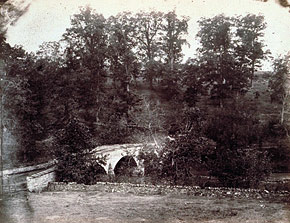
Burnside Bridge,
Antietam National Battlefield
Sharpsburg, Maryland
American Sycamore
TreeSharpsburg, Maryland
History continued
Only days after the battle, Civil War photographer Alexander Gardner arrived to document the scene. In his photographs of Burnside Bridge, a small American Sycamore (Platanus occidentalis) sapling is clearly visible along the eastern bank of Antietam Creek, a few feet north of the bridge. The failed Federal charges were halted within arms reach of its branches. Only a few years old and about 5 feet tall, it somehow stood up to the torrent of Confederate musket fire and artillery, as well as Federal boots, horse hooves, and wagon wheels. Gardner’s focus was understandably the bridge itself, and not the seemingly insignificant little sprout adjacent to it. Antietam became a National Park in 1933 and in the intervening years as this hallowed ground has been visited by millions, this witness tree has grown into a majestic specimen, and has taken on historical import in its own right. Commemorated as a witness to the hard fighting it observed in youth, the tree is today as much a part of the site’s interpretative value as Burnside Bridge itself. Moreover, because of widespread alterations to the physical environment of Antietam National Battlefield throughout the late 19th and early to mid-20th centuries, the Burnside Bridge American Sycamore is likely the sole remaining living spectator of America’s bloodiest day.

Photo by Alexander Gardner, 1862.
Courtesy George Eastman House
In August and September 2003, severe weather nearly accomplished what the battle could not. Strong winds first accompanying severe thunderstorms, and later Hurricane Isabel, brought down a total of 46 trees within the battlefield, many over 100 years old. Wind gusts of up to 100 miles per hour also cracked off three of the witness tree’s largest limbs. Crashing down, the force of their impact broke open a five-foot long by three-foot wide hole in the south wall of Burnside Bridge. National Park Service staff repaired the bridge, and thankfully the tree survived. However, the incident highlights the crucial difference between the two historical symbols; given proper maintenance and repair Burnside Bridge may survive indefinitely, but as with all living things its namesake sycamore will eventually die. That this cultural resource has a definite lifespan, however, does not make its preservation and care any less important, but stewards and visitors alike must accept this eventual outcome.